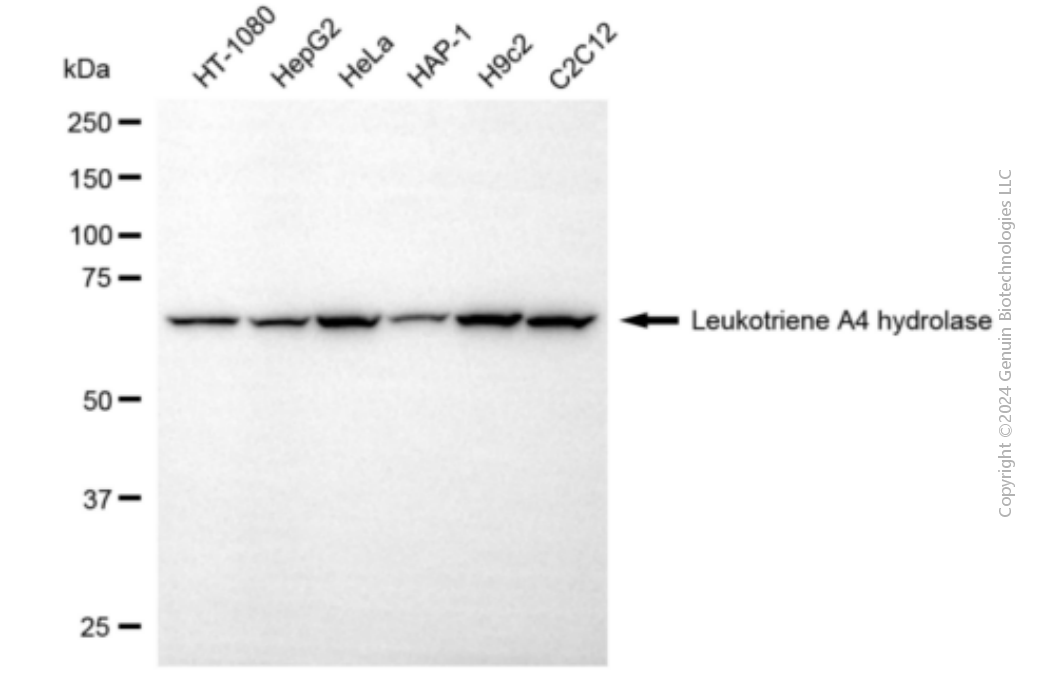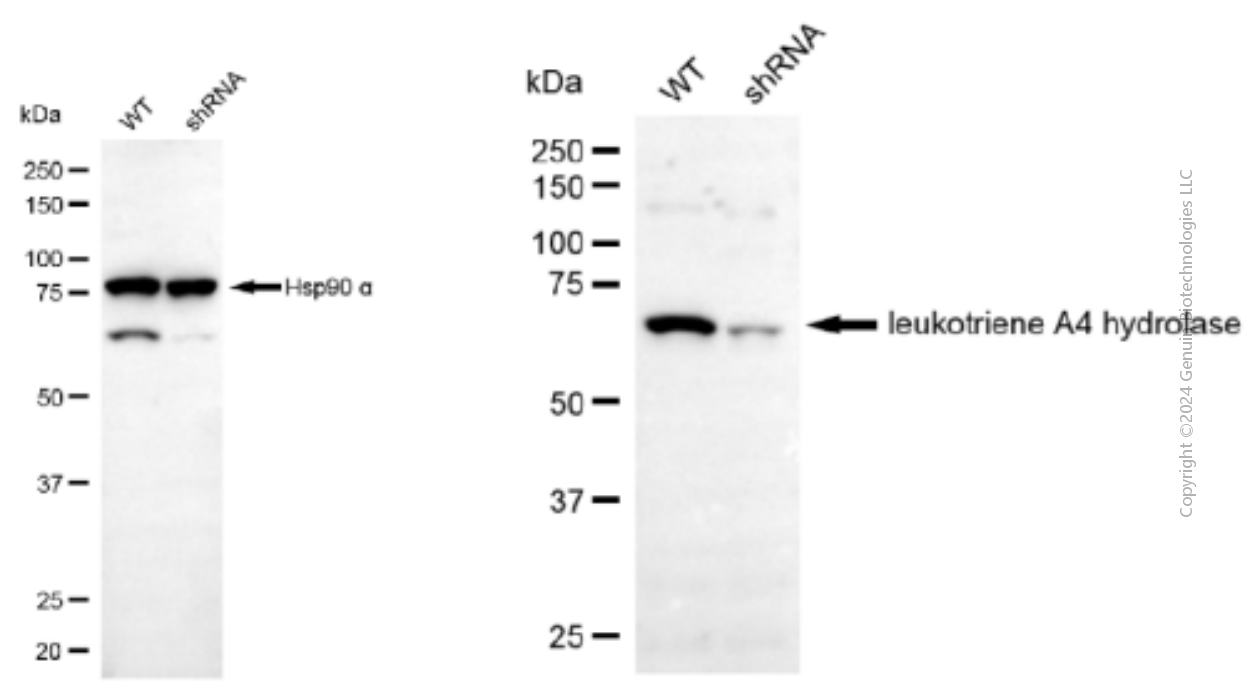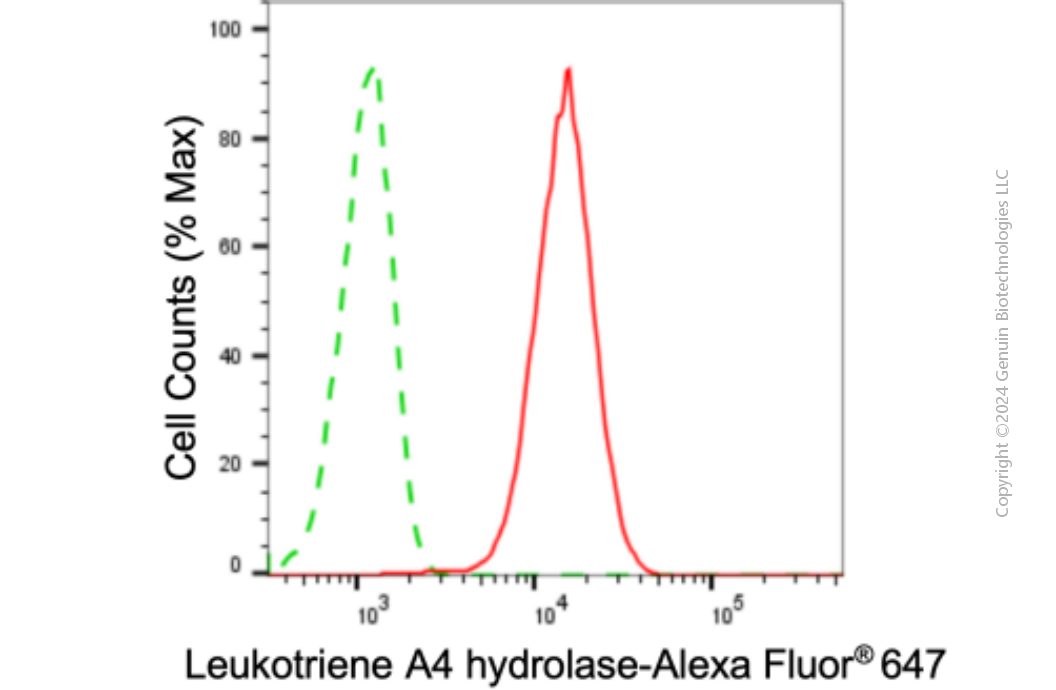KD-Validated Anti-Leukotriene A4 Hydrolase Mouse Monoclonal Antibody
Mouse monoclonal antibody
- SPECIFICATION
- CITATIONS
- PROTOCOLS
- BACKGROUND

Application
| WB, FC |
|---|---|
| Primary Accession | P09960 |
| Reactivity | Rat, Human, Mouse |
| Clonality | Monoclonal |
| Isotype | Mouse IgG2b |
| Clone Names | 24GB5540 |
| Calculated MW | Predicted, 69 kDa, observed, 69 kDa |
| Gene Name | LTA4H |
| Aliases | Leukotriene A4 Hydrolase; Tripeptide Aminopeptidase LTA4H; Leukotriene A-4 Hydrolase; LTA-4 Hydrolase; Testicular Secretory Protein Li 27; Leukotriene A(4) Hydrolase; EC 3.4.11.4; EC 3.3.2.6; LTA4 |
| Immunogen | Recombinant protein of human LTA4H |
| Gene ID | 4048 |
|---|---|
| Other Names | Leukotriene A-4 hydrolase, LTA-4 hydrolase, 3.3.2.6, Leukotriene A(4) hydrolase, Tripeptide aminopeptidase LTA4H, 3.4.11.4, LTA4H, LTA4 |
| Name | LTA4H |
|---|---|
| Synonyms | LTA4 |
| Function | Bifunctional zinc metalloenzyme that comprises both epoxide hydrolase (EH) and aminopeptidase activities. Acts as an epoxide hydrolase to catalyze the conversion of LTA4 to the pro-inflammatory mediator leukotriene B4 (LTB4) (PubMed:11917124, PubMed:12207002, PubMed:15078870, PubMed:18804029, PubMed:1897988, PubMed:1975494, PubMed:2244921). Also has aminopeptidase activity, with high affinity for N-terminal arginines of various synthetic tripeptides (PubMed:18804029, PubMed:20813919). In addition to its pro-inflammatory EH activity, may also counteract inflammation by its aminopeptidase activity, which inactivates by cleavage another neutrophil attractant, the tripeptide Pro-Gly-Pro (PGP), a bioactive fragment of collagen generated by the action of matrix metalloproteinase-9 (MMP9) and prolylendopeptidase (PREPL) (PubMed:20813919, PubMed:24591641). Involved also in the biosynthesis of resolvin E1 and 18S-resolvin E1 from eicosapentaenoic acid, two lipid mediators that show potent anti- inflammatory and pro-resolving actions (PubMed:21206090). |
| Cellular Location | Cytoplasm. |
| Tissue Location | Isoform 1 and isoform 2 are expressed in monocytes, lymphocytes, neutrophils, reticulocytes, platelets and fibroblasts |

Thousands of laboratories across the world have published research that depended on the performance of antibodies from Abcepta to advance their research. Check out links to articles that cite our products in major peer-reviewed journals, organized by research category.
info@abcepta.com, and receive a free "I Love Antibodies" mug.
Provided below are standard protocols that you may find useful for product applications.
If you have used an Abcepta product and would like to share how it has performed, please click on the "Submit Review" button and provide the requested information. Our staff will examine and post your review and contact you if needed.
If you have any additional inquiries please email technical services at tech@abcepta.com.














 Foundational characteristics of cancer include proliferation, angiogenesis, migration, evasion of apoptosis, and cellular immortality. Find key markers for these cellular processes and antibodies to detect them.
Foundational characteristics of cancer include proliferation, angiogenesis, migration, evasion of apoptosis, and cellular immortality. Find key markers for these cellular processes and antibodies to detect them. The SUMOplot™ Analysis Program predicts and scores sumoylation sites in your protein. SUMOylation is a post-translational modification involved in various cellular processes, such as nuclear-cytosolic transport, transcriptional regulation, apoptosis, protein stability, response to stress, and progression through the cell cycle.
The SUMOplot™ Analysis Program predicts and scores sumoylation sites in your protein. SUMOylation is a post-translational modification involved in various cellular processes, such as nuclear-cytosolic transport, transcriptional regulation, apoptosis, protein stability, response to stress, and progression through the cell cycle. The Autophagy Receptor Motif Plotter predicts and scores autophagy receptor binding sites in your protein. Identifying proteins connected to this pathway is critical to understanding the role of autophagy in physiological as well as pathological processes such as development, differentiation, neurodegenerative diseases, stress, infection, and cancer.
The Autophagy Receptor Motif Plotter predicts and scores autophagy receptor binding sites in your protein. Identifying proteins connected to this pathway is critical to understanding the role of autophagy in physiological as well as pathological processes such as development, differentiation, neurodegenerative diseases, stress, infection, and cancer.




